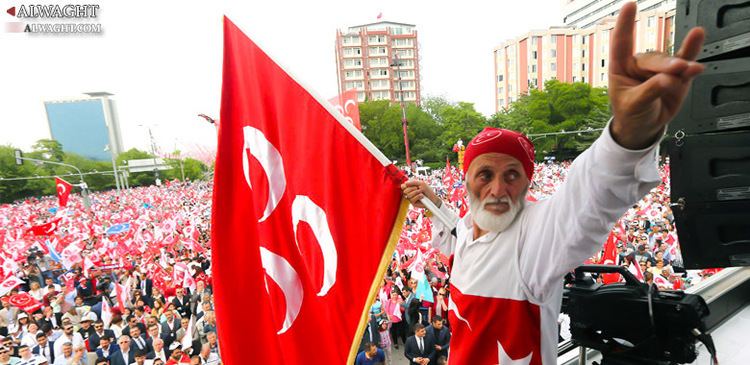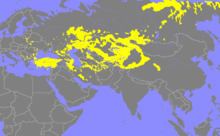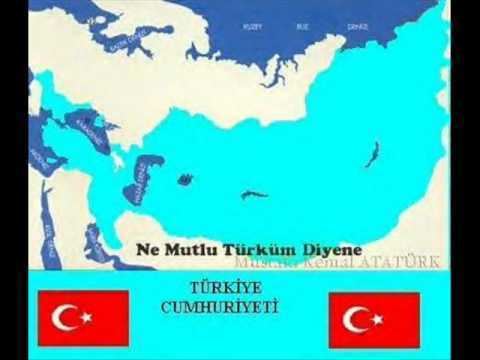 | ||
What is Pan-Turkism? Explain Pan-Turkism, Define Pan-Turkism, Meaning of Pan-Turkism
Pan-Turkism is a movement which emerged during the 1880s among Turkic intellectuals of Azerbaijan (part of the Russian Empire at the time) and the Ottoman Empire (modern day Turkey), with its aim the cultural and political unification of all Turkic peoples. Turanism is a closely related movement but a more general term than Turkism, since Turkism applies only to Turkic peoples. However, researchers and politicians in Turkic ideology have used these terms interchangeably in many sources and literature. Although the Turkic peoples share historical, cultural and linguistic roots, the rise of a pan-Turkic political movement is a phenomenon of the 19th and 20th centuries and was in part a response to the development of Pan-Slavism and Pan-Germanism in Europe and inspired Pan-Iranism in Asia. Ziya Gökalp defined pan-Turkism as a cultural, academic, and philosophical and political concept advocating the unity and freedom of Turkic peoples.
Contents
- What is Pan Turkism Explain Pan Turkism Define Pan Turkism Meaning of Pan Turkism
- Name
- History
- Turkeys role
- Criticism
- Genocide connections
- Nazi Germany
- Historiography
- Turkic nationalism
- Armenian history
- Russian views
- Notable pan Turkists
- Pan Turkist organizations
- Quotations
- References

Name
In research literature, "pan-Turkism" is used to describe the political, cultural and ethnic unity of all Turkic-speaking people. "Turkism" began to be used with the prefix "pan-" (from the Greek πᾶν, pan = all).

Proponents use the latter as a point of comparison, since "Turkic" is more a linguistic and cultural distinction than a racial or ethnic description. This differentiates it from "Turkish", which is an ethnic term for people primarily residing in Turkey. Pan-Turkic ideas and reunification movements have been popular since the collapse of the Soviet Union in Central Asian and other Turkic countries.
History

In 1804, the Tatar theologian Ghabdennasir Qursawi wrote a treatise calling for the modernization of Islam. Qursawi was a Jadid (from the Arabic jadid, "new"). The Jadids encouraged critical thinking, supporting education and the equality of the sexes, and advocated tolerance for other faiths, Turkic cultural unity, and openness to Europe’s cultural legacy. The Jadid movement was founded in 1843 in Kazan. Its aim was a semi-secular modernization and educational reform, with a national (not religious) identity for the Turks. Before that they were Muslim subjects of the Russian Empire, which maintained this attitude until its end.

After the Wäisi movement, the Jadids advocated national liberation. After 1907, many supporters of Turkic unity immigrated to the Ottoman Empire.
The newspaper Türk in Cairo was published by exiles from the Ottoman Empire after the suspension of the 1876 constitution and the persecution of liberal intellectuals. It was the first publication to use the ethnic designation as its title. Yusuf Akçura published "Three Types of Policy" (Üç tarz-ı siyaset) anonymously in 1904, the earliest manifesto of a pan-Turkic nationalism. Akçura argued that the supra-ethnic union espoused by the Ottomans was unrealistic. The Pan-Islamic model had advantages, but Muslim populations were under colonial rule which would oppose unification. He concluded that an ethnic Turkish nation would require the cultivation of a national identity; a pan-Turkish empire would abandon the Balkans and Eastern Europe in favor of Central Asia. The first publication of "Three Types of Policy" had a negative reaction, but it became more influential by its third publication in 1911 in Istanbul. The Ottoman Empire had lost its African territory to Italy and would soon lose the Balkans, and pan-Turkish nationalism became a more feasible (and popular) political strategy.
In 1908 the Committee of Union and Progress came to power in Ottoman Turkey, and the empire adopted a nationalistic ideology. This contrasted with its largely Muslim ideology dating back to the 16th century, when the sultan was a caliph of his Muslim lands. Leaders espousing Pan-Turkism fled from Russia to Istanbul, where a strong pan-Turkic movement arose; the Turkish pan-Turkic movement grew into a nationalistic, ethnically oriented replacement of the caliphate with a state. After the fall of the Ottoman Empire with its multi-cultural and multi-ethnic population, influenced by the nationalism of the Young Turks, some tried to replace the empire with a Turkish commonwealth. Leaders like Mustafa Kemal Atatürk acknowledged that such a goal was impossible, replacing pan-Turkic idealism with a nationalism aimed at preserving an Anatolian nucleus.
The Türk Yurdu Dergisi (Journal of the Turkish Homeland) was founded in 1911 by Akçura. This was the most important Turkist publication of the time, "in which, along with other Turkic exiles from Russia, [Akçura] attempted to instill a consciousness about the cultural unity of all Turkic peoples of the world."
A significant early exponent of pan-Turkism was Enver Pasha (1881–1922), the Ottoman Minister of War and acting commander-in-chief during World War I. He later became a leader of the Basmachi movement (1916–1934) against Russian and Soviet rule in Central Asia. During World War II, the Nazis organized a Turkestan legion composed primarily of soldiers who hoped to develop an independent Central Asian state after the war. The German intrigue bore no fruit.
After the late-20th-century collapse of the Soviet Union, the Turkic peoples were more independent in business and politics:
The aim of all Turks is to unite with the Turkic borders. History is affording us today the last opportunity. In order for the Islamic world not to be forever fragmented it is necessary that the campaign against Karabagh be not allowed to abate. As a matter of fact drive the point home in Azeri circles that the campaign should be pursued with greater determination and severity.
Pan-Turkic movements and organizations are focusing on the economic integration of the sovereign Turkic states and hope to form an economic and political union similar to the European Union.
Turkey's role
Turkey's efforts have not met the expectations of the Turkic states or the country's pan-Turkist supporters. Modest housing projects promised to the Crimean Tatars have not been completed after many years. Although Turkmenistan, Uzbekistan, and Azerbaijan have switched to the Latin alphabet, their alphabets are not as compatible with the Turkish alphabet as Turkey had hoped. Kazakhstan considered switching from Cyrillic to the Latin alphabet, but suspended the project in December 2007. In January 2015, it was announced that the transition plan was again underway. Kyrgyzstan has not seriously considered adopting the Latin alphabet, but the idea was entertained by some politicians during the country's first few years of independence.
Criticism
Pan-Turkism is often perceived as a new form of Turkish imperial ambition. Some view the Young Turk leaders who saw pan-Turkist ideology as a way to reclaim the prestige of the Ottoman Empire as racist and chauvinistic. Some scholars believe that pan-Turkism guided ethnic cleansing, such as the Armenian, Greek, and Assyrian genocides.
Genocide connections
The agents of the Armenian genocide during the First World War advocated pan-Turkism, and Enver Pasha was a key player in the attempt to remove non-Muslim minorities from the Ottoman Empire to build a new pan-Turkic state. The Greek genocide refers to the fate of the Greek population of the Ottoman Empire during and after World War I and the ensuing 1919–22 Greco-Turkish War. Like the Armenians and Assyrians, the Greeks were massacred, expelled, and marched to death by the Ottoman government. George W. Rendel of the British Foreign Office and other diplomats noted the massacres and deportations of Greeks after the armistice. Hundreds of thousands of Ottoman Greeks are estimated to have died during this period. A population exchange between Greece and Turkey occurred in 1923 after the Greco-Turkish War. Most of the exchange was disorganized, with Turks and Greeks fleeing from each other's country. Many people were unaccounted for, causing some scholars to suspect a more-brutal, ideologically motivated expulsion of Greeks from Turkey. The Armenian, Greek, and Assyrian genocides took place under the Three Pashas of the Ottoman Empire. A 1922 memorandum from the Assyro-Chaldean National Council estimated that about 275,000 Assyrians were killed.
Nazi Germany
During the 1940s, pro German pan-Turkists absorbed Nazi propaganda. Some sources claims Nihal Atsız advocated Nazi doctrines and adopted a Hitler-style haircut and mustache. Alparslan Türkeş, a leading pan-Turkist, took a pro-Hitler position during the war and developed close connections with Nazi leaders in Germany. Several pan-Turkic groups in Europe apparently had ties to Nazi Germany (or its supporters) at the start of the war, if not earlier. The Turco-Tatars in Romania cooperated with the Iron Guard, a Nazi-inspired organization. Although Turkish government archives for the World War II years have not been released, the level of contact can be ascertained from German archives. Although early in the war the Turkish government was officially neutral, confidential semi-official contacts between Germany and Turkey began in 1941.
There was sympathy for Germany in Turkey at the time, and a ten-year Turco-German treaty of friendship was signed in Ankara on 18 January 1941. Official and semi-official meetings between German ambassador Franz von Papen and other German officials and Turkish officials, including General H. E. Erkilet (of Tatar origin and a frequent contributor to pan-Turkic journals) took place in the second half of 1941 and the early months of 1942. The Turkish officials included General Ali Fuad Erdem and Nuri Pasha, brother of Enver Pasha.
While Erkilet discussed military contingencies, Nuri Pasha told the Germans about his plan to create independent states which would be allies (not satellites) of Turkey. These states would be formed from the Turkic-speaking populations in Crimea, Azerbaijan, Central Asia, northwest Iran, and northern Iraq. Nuri Pasha offered to assist propaganda activities for this cause. However, Turkey also feared the Turkic minorities in the USSR and told von Papen that it could not join Germany until the USSR was crushed. The Turkish government may have been apprehensive about Soviet might, which kept the country out of the war. On a less-official level, Turkic emigrants from the Soviet Union played a crucial role in negotiations and contacts between Turkey and Germany; among them were pan-Turkic activists Zeki Velidi Togan, Mammed Amin Rasulzade, Mirza Bala, Ahmet CafarOglu, Sayid Shamil and Ayaz Ishaki. Several Tatar military units of Turkic speakers in the Turco-Tatar and Caucasian regions who had been prisoners of war joined the war against the USSR, generally fighting as guerrillas in the hope of independence and a pan-Turkic union. The units, which were reinforced, numbered several hundred thousand. Turkey took a cautious approach at the government level, but pan-Turkist groups were exasperated by Turkish inaction and what they saw as the waste of a golden opportunity to reach the goals of pan-Turkism.
Historiography
Pan-Turkism and nationalist historiography has been used to deny the identity of Armenians and Kurds. At the same time, various revisionist claims were made on ancient peoples of the region and beyond.
Turkic nationalism
Most of the Turkic peoples settled in presesent-day territories during the Turkic migrations by assimilating or pushing previous settlers and issue of indigeneity is major problem for Turkic nationalist historiography and ideology. Many historical researches of Turkic writeres considered as falsifiactions.
Some Turkic nationalists believe that major civilizations of the past—Minoan, Chinese, Indian, Muslim, even ancient Egyptian, and Etruscan—were of Turkic origin. Kairat Zakiryanov considers the Japanese and Kazakh gene pools to be identical.
Turkic nationalist writers posit that Eurocentrist colonial regimes falsified and divided Turkic history and Turkic peoples, in justice, must return to Turkic territories. The pseudoscientific Sun Language Theory that all human languages are descendants of a proto-Turkic language was developed by Turkish president Mustafa Kemal Atatürk during the 1930s. In 2012, a Kyrgyz website accused Kazakhs and Uzbeks of appropriating Kyrgyz history.
Although some Uyghur people believe that the Indo-European-speaking Tocharians were ancestors of the Uyghurs scholars do not consider modern Uyghurs to be descended from them or the Uyghur Khaganate. Modern Uyghurs are considered to be descendants of several peoples (one of them the ancient Uyghurs) because the ethnic groups are linguistically and genetically different.
Armenian history
Clive Foss, professor of ancient history at the University of Massachusetts Boston, has done extensive archeological work in Turkey and is an expert on ancient Armenian coins. In his article, "The Turkish View of Armenian History: A Vanishing Nation", Foss writes that the Turkish government was "systematically changing the names of villages to make them more Turkish. Any name which does not have a meaning in Turkish, or does not sound Turkish, whatever its origin, is replaced by a banal name assigned by a bureau in Ankara, with no respect to local conditions or traditions". According to Foss, the Turkish government "presented [Armenia] ambiguously, without clear identification of [its] builders, or as examples of the influence of the superiority of Turkish architecture. In all this, a clear line is evident: the Armenian presence is to be consigned, as far as possible, to oblivion".
Foss notes critically that in 1982: The Armenian File in the Light of History, Cemal Anadol writes that the Iranian Scythians and Parthians are Turks. According to 'genius' Anadol, the Armenians welcomed the Turks to the region; their language is a mixture with no roots and their alphabet is mixed, with 11 characters from the ancient Turkic alphabet. Foss calls this view historical revisionism: "Turkish writings have been tendentious: history has been viewed as performing a useful service, proving or supporting a point of view, and so it is treated as something flexible which can be manipulated at will". He concludes, "The notion, which seems well established in Turkey, that the Armenians were a wandering tribe without a home, who never had a state of their own, is of course entirely without foundation in fact. The logical consequence of the commonly expressed view of the Armenians is that they have no place in Turkey, and never did. The result would be the same if the viewpoint were expressed first, and the history written to order. In a sense, something like this seems to have happened, for most Turks who grew up under the Republic were educated to believe in the ultimate priority of Turks in all parts of history, and to ignore Armenians all together; they had been clearly cosigned to oblivion."
Western Azerbaijan is a term used in Azerbaijan to refer to Armenia. According to the Whole Azerbaijan theory, modern Armenia and Nagorno-Karabakh were once inhabited by the Azerbaijanis. Its claims are based on the belief that current Armenia was ruled by Turkic tribes and states from the Late Middle Ages to the Treaty of Turkmenchay signed after the Russo-Persian War, 1826-1828. The concept has been sanctioned by the government of Azerbaijan and its current president, Ilham Aliyev, who has said that Armenia is part of ancient Turkic, Azerbaijani land. Turkish and Azerbaijani 'historians' have said that Armenians are alien, not indigenous, in the Caucasus and Anatolia.
Russian views
In Tsarist Russian circles, pan-Turkism was considered a political, irredentist and aggressive idea. Turkic peoples in Russia were threatened by Turkish expansion, and I. Gasprinsky and his followers were accused of being Turkish spies. After the October Revolution, the Bolshevik attitude to Türkism did not differ from the attitude of the Russian Empire. At the 10th Congress of Bolshevik Communist Party in 1921, the party "condemned pan-Turkism as a slope to bourgeois-democratic nationalism". The emergence of a pan-Turkism scare in Soviet propaganda made it one of the most frightening political labels in the USSR. The most widespread accusation used in the lethal repression of educated Tatars and other Turkic peoples during the 1930s was that of pan-Turkism.
Russia, China, and Iran say that they perceive pan-Turkism as a new form of Turkish imperial ambition, and some see it as racist, despite the fact that Turks are clearly not of a single race. Critics believe that the concept is flawed because of the distinct dialects spoken by the Turkic peoples, which sometimes led to miscommunication. Concerns also exist about religious differences. Although most Turks are Sunni Islam, the Azerbaijanis are Shi'a. According to some nationalist critics, pan-Turkists are at the forefront of historical revisionism about world history in general and Turkic history in particular.
